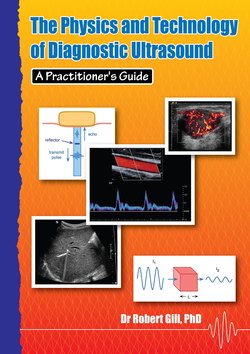Читать книгу The Physics and Technology of Diagnostic Ultrasound: A Practitioner's Guide - Robert Gill - Страница 27
На сайте Литреса книга снята с продажи.
Chapter 3: Pulsed ultrasound and imaging Pulsed ultrasound Pulse duration and bandwidth
ОглавлениеAs mentioned in chapter 1, ultrasound imaging makes use of short "pulses" of ultrasound which are transmitted into the body. What do we mean by a pulse of ultrasound, and why do we need to use pulses?
The term pulse refers to ultrasound energy that starts and then stops again shortly afterwards, i.e. a short "burst" of ultrasound energy. Figure 3.1 shows a typical ultrasound pulse. (Remember that the opposite of a pulse is "continuous wave" ultrasound which continues indefinitely.)
Figure 3.1 A typical transmit pulse, in this case lasting a total of four cycles. Note that the amplitude builds to a maximum and then decreases again. The overall time is referred to as the "pulse duration".
Generally the pulse used for ultrasound imaging is 3 - 5 cycles in length, and so the pulse duration will be 3 - 5 times the period of the ultrasound wave. (Remember, the period is the duration of a single cycle.) For example, suppose the pulse shown in Figure 3.1 has a frequency of 4 MHz. Since the period corresponding to a frequency of 4 MHz is 0.25 μsec and since the pulse is 4 cycles long, the pulse duration is simply (4 × 0.25 μsec) = 1.0 μsec.
When ultrasound is reflected or scattered by structures in the body, echoes will return to the probe and they will produce electrical signals that the machine processes to create the ultrasound image. Since the transmit pulse has the form shown in Figure 3.1, each echo will have exactly the same duration and shape (it too will last just a few cycles).
Why is it necessary to use such short pulses of ultrasound? We will see in later chapters that this produces images with good resolution.
The shorter the transmit pulse the better the image resolution.
As we have just seen, a short transmit pulse can be achieved by (a) transmitting only a few cycles and (b) using as high an ultrasound frequency as possible, since the higher the frequency the shorter the period and so the shorter the total pulse duration will be. This is consistent with the statement in chapter 2 that the higher the frequency the better the resolution.
What are the implications of making the transmit pulse short? To answer this, we need to consider the concept of ultrasound frequency again.
As we saw in chapter 2, a sinusoidal continuous wave is the simplest form of ultrasound wave, having a single well-defined frequency, amplitude etc. It is also a useful building block to describe more complex waveforms. Thus we saw that a distorted continuous wave could be broken up into the sum of a number of sinusoidal waves with specific frequencies (f, 2f, 3f, ... etc).
The situation with a pulse is somewhat different. Frequency analysis shows that an ultrasound pulse can be broken up into the sum of an infinite number of sinusoidal waves with frequencies spanning a defined frequency range (see Figures 3.2 and 3.3). While it may seem remarkable that adding an infinite number of continuous waves together can give a pulse that lasts just a short period of time, it is true.
Figure 3.2A short pulse of 4 MHz ultrasound can be shown mathematically to be the sum of an infinite number of continuous sinusoidal waves with frequencies ranging from 3.5 MHz to 4.5 MHz. Just five of the continuous waves are shown in this diagram for simplicity.
A more convenient way of showing the frequency range is the "frequency spectrum" – a diagram showing the range of frequencies that go to make up the pulse and the power at each frequency – as shown in Figure 3.3.
Figure 3.3 The "spectrum" of the pulse in Figure 3.2. Note the definitions of the centre frequency and the bandwidth.
What determines the dimensions of this spectrum? The centre frequency is simply the frequency of oscillation of the pulse (4 MHz in this example); the bandwidth (B) is related to the pulse duration (τ) by a very simple equation:
In this case the pulse duration is 1 μsec and so the bandwidth is 1 MHz. The shape of the spectrum is determined by the overall shape of the transmit pulse (i.e. the way its amplitude increases and decreases).
Notice that the relationship between pulse duration and bandwidth is an inverse one. This means that if the pulse gets shorter then the bandwidth becomes larger. In other words, a bigger range of frequencies must be combined together if you want to create a very short pulse. For example, Figure 3.4 shows the spectrum for a 4 MHz pulse just two cycles long. Notice that the centre frequency is still 4 MHz but the bandwidth has doubled because the pulse duration has halved.
Figure 3.4 Spectrum showing the effect of halving the transmit pulse duration compared with Figure 3.3.
Conversely, if the pulse becomes very long, the bandwidth will become small. At the extreme limit, the bandwidth becomes zero for a continuous wave which lasts for ever (i.e. there is no range of frequencies, just a single frequency, as shown in Figure 3.5).
Figure 3.5 Spectrum for a continuous wave signal.
Why does the bandwidth matter? An ultrasound transducer (the active element in the probe) inherently has a limited bandwidth, i.e. it can only process electrical and ultrasound signals within a defined range of frequencies. Since it is difficult for the manufacturers to increase transducer bandwidth, they must ensure that the transmit pulse is designed so that the full range of frequencies that it contains fall within the range that the transducer can process. (If the bandwidth of the transducer is too small, it will force the transmit pulse to become longer.)
